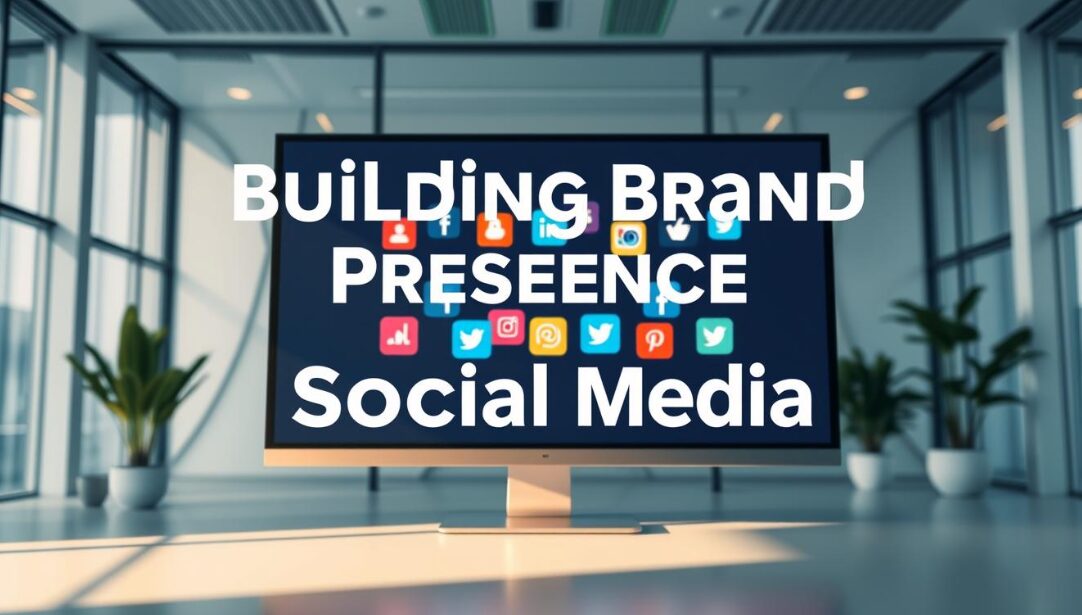In the fast-paced world of e-commerce, many small businesses have grown thanks to smart marketing. For example, a local artisan started selling handcrafted toys online. They used old marketing ways but found it hard to reach more people.
But then, they turned to social media marketing. They posted pictures of their toys, talked to customers, and used Instagram and Facebook for shopping. This made their sales jump up. They saw that 5 billion social media users could help them find their perfect customers.
Social media marketing is now key for businesses wanting to be seen and sell more. It’s about making interesting content or using what customers say about you. By using the tips in this article, we can improve our social media game. For more info, check out this guide on social media marketing for e-commerce.
Table of Contents
Key Takeaways
- Over 40% of consumers discover new products via social media.
- Social media can significantly enhance brand awareness and visibility.
- Engaging content and authenticity drive customer loyalty and sales.
- Incorporating user-generated content serves as powerful social proof.
- Automation tools are essential for prompt engagement on social platforms.
- Data analytics help refine strategies and improve marketing effectiveness.
Understanding the Importance of Social Media Marketing
Social media marketing is key for digital commerce. Online shopping has grown a lot, thanks to its ease and wide range of options. It’s clear why social media is vital for e-commerce brands wanting to connect and be seen more.
The Growth of E-commerce in the Digital Age
Online shopping has changed a lot in the last ten years. With 4.76 billion social media users worldwide, more people are buying online. By 2025, half of Gen Z will shop more on social networks. Businesses need to update their online marketing to keep up.
Why Social Media Matters for E-commerce
Social media is very important for e-commerce. 39% of people buy things on Facebook, and 36% on TikTok. This shows a move towards platforms that mix content and shopping well.
Good social media strategies can build brand loyalty. 73% of users will leave if a brand doesn’t answer their questions. This shows the need for e-commerce brands to be active on these platforms.
Current Trends in Social Media Marketing
Businesses need to keep up with social media trends. Live shopping and videos are getting more popular. Using engaging content can lead to more sales.
Now, 20% of marketing budgets go to social media. This shows its big role in brand strategies. For more on the benefits, check out this blog.
Key Platforms for E-commerce Social Media Marketing
Knowing different platforms can really help our Social Media Strategies for Online Stores. Each one has its own benefits for E-commerce Social Media Promotion. This lets brands reach their audience well. Let’s look at the main platforms that can boost sales through a strong social media presence.
Facebook: The Giant of Social Engagement
Facebook is a big name in social media, with nearly 1.5 billion active users. People spend about 40 minutes daily on it, giving businesses a chance to connect. Facebook ads get an average of 12 clicks a month, showing how ads can grab attention.
This level of interaction is key for e-commerce brands. It shows how important Facebook is in making buying decisions.
Instagram: Visual Appeal for Products
Instagram has over one billion monthly active users, a big number. It’s all about visuals, letting brands show off products in creative ways. Around 81% of users look at Instagram for product ideas, showing its value in the buying process.
Instagram ads might cost more than Facebook’s, but they often reach more people organically. This makes them a good choice for brands wanting more visibility.
Pinterest: A Hub for Inspiration and Shopping
Pinterest is a visual discovery tool that’s great for e-commerce marketing. Users save content they like, leading to buying decisions. It’s perfect for those looking for inspiration and shopping ideas.
By using Pinterest well, businesses can reach a market where people are actively looking for products.
TikTok: The New Frontier of Brand Storytelling
TikTok is quickly becoming popular, with one billion monthly active users. It’s great for younger people and tells stories through creative videos. With 46% of users only using TikTok, brands can grab attention like never before.
Successful marketing on TikTok often involves working with influencers and joining trends. For more on TikTok strategies, check out this detailed guide that shares effective tactics.
Developing a Social Media Strategy for E-commerce
Creating a good social media plan for e-commerce sites begins with clear goals. Businesses need to decide if they want more traffic, to be seen more, or to sell more. Having specific goals, like growing sales by 20% in six months, helps guide social media efforts.
Setting Clear Marketing Goals
It’s important to have clear and measurable goals. This could mean aiming to get 30% more website visitors in three months or to see a 15% increase in repeat customers in a year. Checking these goals often keeps them on track.
Identifying Your Target Audience
Knowing who you’re talking to is key. Over 50% of Gen Z use social media to check out brands. It’s essential to understand what your audience likes and does to make content that really speaks to them.
Choosing the Right Social Media Platforms
Picking the right social media sites is critical for success. Each site has its own strengths and who uses it. For example, TikTok is growing fast and could be a big player in 2024, with 36.9% of buyers planning to shop there. Knowing who uses each site and what they like helps make your marketing more effective. For more tips, check out this resource.
Creating Engaging Content for Social Media
Engaging content is the heart of our social media marketing plan. We aim to share images, videos, polls, and content from our followers. This mix keeps our audience interested and helps them interact with us.
Research shows 81% of people use social media to find new products. This highlights the need for content that speaks to our audience’s interests.
Types of Content That Drive Engagement
Images can make our posts 94% more popular than those without. Videos can increase conversion rates by up to 200% for online shops. User-generated content (UGC) boosts engagement by 28%.
We should create eye-catching graphics, engaging videos, and informative infographics. This will help us reach more people and get noticed.
Balancing Promotional and Informational Content
It’s important to mix promotional and informative content. A good plan can grow our followers and reach. Promotional posts can sell more, while informative ones build trust.
Try to share 70% valuable content and 30% promotional stuff. This can make 78% of consumers trust our brand more because of our social media presence.
The Power of Storytelling in Marketing
Storytelling makes our marketing more personal. It can increase customer loyalty by up to 65%. This emotional bond leads to more repeat business and a sense of belonging.
Sharing customer stories and testimonials is also powerful. They are trusted 12 times more than our product descriptions. By mixing our products with customer stories, we create a lasting impression.
In summary, the right content can boost our e-commerce, loyalty, and customer satisfaction. By keeping our strategy fresh and engaging, we stay ahead in the digital world. Understanding content creation is key to our growth.
Using effective SEO strategies is also vital. For example, strong backlink strategies can improve our visibility and rankings. Learn more about these strategies in this insightful article on SEO backlink strategies for Shopify stores.
Leveraging User-Generated Content
User-generated content is key to building trust and engagement in e-commerce. It shows real experiences from customers, creating a sense of community. This approach boosts confidence and affects buying decisions.
With 75% of people buying after seeing products on social media, using User-Generated Content in E-commerce is vital.
Encouraging Customers to Share Their Experiences
We can spark creativity in our customers to share their stories. Using branded hashtags or contests is a great way to do this. It boosts our brand’s visibility and gathers real content.
This method is effective, as 70% of millennials are influenced by such content when buying. It makes our Social Media Advertising for E-commerce richer.
Showcasing Customer Reviews and Testimonials
Customer reviews can greatly improve our brand’s trustworthiness. About 70% of shoppers check reviews before buying. Positive feedback reassures and boosts sales.
Brands using user-generated content see a 270% rise in e-commerce site conversions. This shows the power of real feedback.
The Impact of Influencer Collaborations
Working with influencers can spread the word about our content. They offer a trusted voice, reaching more people. Their involvement leads to better engagement and sales.
User-generated content has a four times higher click-through rate than traditional ads. It can increase conversion rates by 15% with regular use.
Building a Robust Brand Presence
A strong brand presence on social media is key to attracting more people. It’s about being consistent in what we show and say. Every post should reflect our brand’s personality and values, making us stand out.
Regularly talking to our audience boosts our visibility. This helps more people find out about what we offer.
Consistency in Branding Across Platforms
Keeping our branding the same on all social media platforms is important. It makes us look more reliable and professional. Brands that post regularly get up to 67% more engagement than those that don’t.
This consistency builds trust and creates a stronger connection with our customers.
Crafting an Effective Brand Voice
Having a unique brand voice is key to connecting with people. Our voice should be relatable, whether it’s playful, professional, or informative. It should make our audience feel heard and valued.
Being real in our communication can make people loyal to our brand. In fact, 71% of people who have a good experience with a brand on social media will recommend it.
Engaging with Your Audience
Engagement is vital for a strong brand presence on social media. By responding to comments and messages, we build a community. Social media gives us a huge chance to interact with people, with 60% preferring to talk to brands here.
By engaging, we not only make our customers happier but also increase their spending. Brands that talk to their audience see a 20-40% rise in spending. It’s all about creating a space for conversation and building loyalty.
Utilizing Paid Advertising on Social Media
Investing in paid ads is key to growing our reach in the competitive world of E-commerce Marketing on Social Media. We can use carousel ads, video ads, and dynamic ads made for e-commerce. Each type has its own benefits and helps us reach different people.
Types of Paid Ads Suitable for E-commerce
Facebook and Instagram offer many campaign goals like awareness and sales. With over 3 billion users on Facebook, it’s great for targeted ads. TikTok, with its young audience, is perfect for short videos that can lead to sales.
Budgeting for Social Media Advertising
Setting a realistic budget is vital for Social Media Advertising for E-commerce. Starting small lets us test and grow successful campaigns. Tools like Semrush help us track how well our ads are doing.
Measuring the Success of Paid Campaigns
We should look at metrics like conversion rates and click-through rates to see how well our ads are doing. Social media’s retargeting options can boost our visibility and sales. By measuring our success, we can make our digital presence even stronger. For more on marketing, check out this resource.
Monitoring and Analyzing Performance
To boost our e-commerce success, we must keep a close eye on our performance. Tracking key metrics helps us understand how our marketing is doing. This way, we can make smart changes based on the data. With over 4.7 billion people on social media, using Analytics Tools for Social Media is key to measuring our success.
Key Metrics to Track for E-commerce Success
Metrics like engagement rate, reach, and conversion rates are vital. A high engagement rate shows we’re connecting well with our audience. It means they trust and support us. The engagement rate formula helps us measure this.
Click-through rate (CTR) also tells us how interesting our content is. For example, if a post gets 36 views and 15 clicks, its CTR is about 40%.
Using Insights to Adjust Strategies
By monitoring our activities, we can tweak our strategies. Metrics like shopping cart abandonment rate and sales conversion rate are important. They show us where we can do better.
Doing sentiment analysis helps us understand how people feel about our brand. This gives us a deeper look at what our audience thinks. Regularly checking these metrics helps us stay on track and learn from our competitors.
Tools for Social Media Analytics
Tools like Brand24 and Google Analytics are great for Monitoring E-commerce Performance on Social Media. They give us insights into how our campaigns are doing. By tracking metrics like customer lifetime value and average order value, we can make better marketing choices.
Using these tools helps us refine our strategies. This leads to better engagement and sales.
Handling Customer Service via Social Media
In today’s fast world, Customer Service on Social Media is key for e-commerce. Quick and helpful answers keep customers happy and loyal. Showing we care through social media boosts our brand image.
Importance of Responsiveness
Good customer service on social media matters a lot. A third of users prefer it over phone or email. They want answers fast, with 42% expecting a reply in 60 minutes.
Ignoring messages can make 15% more customers leave. It also stops others from talking to us.
Addressing Customer Complaints and Feedback
Handling complaints well can change bad experiences into good ones. About 67% of people ask for help on Twitter and Facebook. When we respond well, 71% of them will suggest our brand to others.
Listening to feedback builds strong relationships. This can lead to more business from them.
Building Relationships Through Social Engagement
Being active on social media is important for building relationships. Studies show 75% of people share good experiences if they feel connected. They also spend 20-40% more when they feel engaged.
Integrating E-commerce with Social Media Features
Businesses are now combining e-commerce with social media to improve shopping for customers. This move is expected to grow, with social commerce valued at around $2.9 trillion by 2026. It’s key for brands to use these platforms well.
Features on social media make buying products easy. This lets consumers shop directly from their favourite sites.
Utilizing Shopping Features on Instagram and Facebook
Instagram and Facebook have changed online shopping with in-app buys and shopping tabs. With over 4.5 billion users, these tools help show products in a nice way. They also help engage people.
Instagram Shops and Facebook Shops let brands offer a neat shopping experience. This makes buying easier and cuts down on people leaving their carts.
The Role of Links and Calls to Action
Clear calls to action are important for social media and e-commerce. They help users go from seeing a product to buying it. A “Shop Now” button or links in Facebook stories can really help.
As 50% of people are more likely to buy from brands they follow, direct links are a big plus. They can make more people buy.
Streamlining Checkout Processes
To make e-commerce and social media work well together, checkout must be easy. Offer many payment options and make sure it’s safe. This makes users happy and can lead to more sales.
With mobile cart abandonment near 86%, making checkout simple is key. Using social media features is not just a trend. It’s a must for better customer service and interaction.
Trends to Watch in Social Media Marketing
Digital marketing is always changing, and knowing the latest trends is key for e-commerce success. Social media marketing is evolving, with new trends affecting advertising and how people shop. Live shopping, focusing on sustainability, and using artificial intelligence (AI) in marketing are big changes. These trends help businesses connect better with customers and make marketing easier.
The Rise of Live Shopping Events
Live shopping events are becoming more popular. They let brands talk directly to customers in real-time. This way, people can ask questions and get answers right away. It’s a big part of Trends in Social Media Marketing for e-commerce and helps increase sales.
Sustainability and Brand Transparency
Now, people want to buy from brands that care about the planet and are honest. They look for brands that talk openly about their green efforts and fair practices. This trend is all about building real connections between brands and their customers.
Emergence of AI in Social Media Marketing
Artificial intelligence is becoming more important in marketing. It helps make ads more personal, automates tasks, and connects with customers better. Many marketers see AI as a game-changer, creating new jobs and making work easier. As we move towards 2025, businesses will post more on social media, showing how AI helps manage content.
| Trend | Description | Impact on E-commerce |
|---|---|---|
| Live Shopping Events | Real-time interaction between brands and consumers. | Increased conversion rates through direct engagement. |
| Sustainability | Consumers demand transparency and ethical practices. | Strengthened brand loyalty and trust. |
| AI Integration | Automation and personalisation of marketing strategies. | Improved efficiency and customer engagement. |
Future of Social Media Marketing for E-commerce
The future of E-commerce social media marketing is set for big changes in the next five years. This is thanks to the fast growth of social commerce and more people shopping on their phones. Brands that use social media well can see up to a 32% boost in sales.
This shows how important it is for businesses to keep up with new trends. Adapting to consumer behaviour in e-commerce will not only improve engagement but also help businesses grow. As people want more convenience and personalisation, staying flexible is key.
Looking ahead, using advanced tech like AI and interactive content will make customer experiences better. For example, dynamic retargeting ads can cut down on cart abandonment. Live shopping events show how important real-time content is for making sales.
With 80% of businesses planning to use AI chatbots by 2025, we need to focus on making a personal connection with our audience. This will help us stay ahead of the competition.
To keep up, we must watch key metrics and use data analytics. As people want quicker responses, building a community through active engagement is vital. Investing in real influencer partnerships and user-generated content will also boost brand authenticity and visibility.
By keeping an eye on trends and changes in social commerce, we can confidently navigate the future of E-commerce social media marketing. This approach will help us stay innovative and ahead of the game.
FAQ
What is the role of social media marketing for e-commerce stores?
Social media marketing helps e-commerce stores connect with customers. It boosts brand visibility and drives sales. It’s a way to engage with the audience and promote products.
How can social media strategies boost e-commerce sales?
Tailored social media strategies can attract more customers. They include engaging content, influencer collaborations, and user-generated content. This builds brand loyalty and increases sales.
Which social media platforms are best for e-commerce marketing?
Facebook, Instagram, Pinterest, and TikTok are top choices for e-commerce marketing. They offer unique features to enhance product discovery and customer engagement.
How important is content creation in e-commerce social media marketing?
Content creation is key in social media marketing. Using various content types keeps audiences interested. It promotes products effectively.
What is user-generated content, and why is it important?
User-generated content (UGC) is content made by customers. It’s powerful social proof. It builds trust and encourages purchases.
How can I measure the success of my social media marketing campaigns?
Success is measured by engagement rates, conversion rates, and click-through rates. Analyzing these metrics helps improve strategies for better results.
Why is consistency in branding important on social media?
Consistent branding creates a recognisable identity. It resonates with the target audience and builds trust. Every post should reflect the brand’s personality and values.
How can I leverage paid advertising for my e-commerce business on social media?
Paid advertising expands your reach with various ad formats. Set a clear budget and aim for a positive ROI. This effectively uses social media advertising.
What practices can improve customer service via social media?
Being responsive to inquiries and complaints improves customer satisfaction. Personalised communication and genuine engagement build relationships. This encourages repeat business and loyalty.
What future trends should e-commerce businesses watch in social media marketing?
Watch for live shopping events, a focus on sustainability and transparency, and AI in marketing. These trends enhance customer engagement and personalisation.







